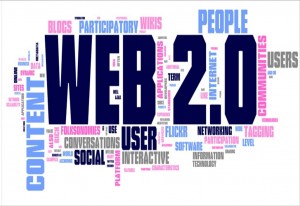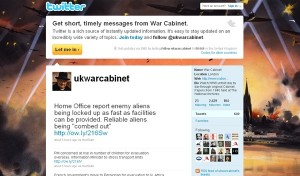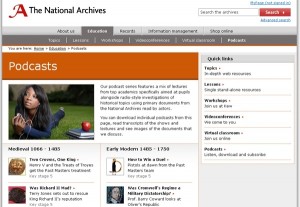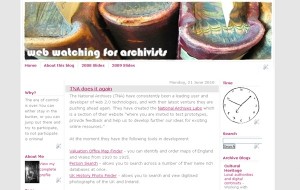Archives 2.0
Posted by guestblogger on June 28th, 2010
About this Guest Post
In this guest blog post Kiara King talks about web 2.0 for archives and the blog she maintains on the subject called ‘web watching for archivists’.
Kiara King is the Archivist for the Ballast Trust, a charitable foundation that provides a rescue, sorting and cataloguing service for business archives with an emphasis on technical records such as plans, drawings and photographs. She can be contacted at: kiaraking@gmail.com.
Archives 2.0
Web 2.0 and me
I first began dabbling in web 2.0 stuff in a personal capacity, with a little bit of facebook at University, some photo sharing and then a few blogs. When I came to decide on a subject for my archive masters’ dissertation in 2007, I wanted to explore how Web 2.0 could work for archives and their users and what the benefits were.
My dissertation looked at how archives could use four of the main Web 2.0 tools – blogs; photo-sharing sites; podcasts and wikis. I researched and found many exciting examples of innovative use of Web 2.0 in archives across the world and I included case studies to illustrate the benefits that using these tools brought to repositories, with a focus on UK examples where possible.
After I graduated, I continued to take an interest in “Archives 2.0” and when I was asked to give a presentation at the 2008 Society of Archivists conference on Web 2.0 I thought it would be useful to start a blog to give me a space to pull together and share the examples I’d found.
Web watching for archivists
I use my blog to share those examples I find and like of archives and archivists using Web 2.0 technologies today. I try to concentrate on UK examples as I think that Kate Theimer of Archives Next already does an excellent job of showcasing the good work that happens everywhere, particularly in North America as well as writing thought provoking posts and generating discussions on web 2.0 and archives.
I originally started my blog by writing up my presentation as a series of blog posts, with one on blogs, one on flickr, etc. Since then I’ve added example to these categories and expanded its scope with posts on new technologies like twitter and youtube, open source software, how to find advice and resources for learning about web 2.0 and even a new category on whimsy for things like the blog Mustaches of the Nineteenth Century!
Web 2.0 and archives
How do I think web 2.0 can help your archive? In exactly the same way it helps museums and libraries – to create new opportunities to connect with your users and raise the profile of your collections. Essentially Web 2.0 represents opportunities for archives. Opportunities to reach wider audiences, use collections in different ways, engage with users and improve the web presence of your repository. Web 2.0 allows you to:
Share your collections
Using a photo-sharing website like Flickr allows you to reach a potential audience of 40 million members. Archives can use Flickr to share digital images of their collections and encourage comments about them like the British Postal Museum and Archive has done. Or you can collect new images from the public like the Great War Archive project at Oxford University did.
Communicate differently
Starting a blog allows you to share news, promote events at your archive, host small online exhibitions, share the progress of a cataloguing project and generally update readers with any items of interest. Blogs are an easy and free way to provide a secondary public face for your organisation, one that may be more accessible and less formal than the official website.
Some examples of UK repository or collection blogs include the Orkney Archive blog, Special Collections at the University of Bradford and the Bartholomew Archive blog at the National Library of Scotland. There is also the excellent Archives Hub blog.
Twitter is blogging on a smaller scale with a maximum of 140 characters per ‘tweet’ and because of that lends itself to more frequent updates and informal commentary on your collections, linking back to your website or blog for the full story. Examples I like include Strathclyde Archive and Wiltshire Archive’s list of documents being consulted.
You can also use twitter or a blog to repurpose archival content by tweeting or posting diary entries or other collections like the War Cabinet papers being tweeted by the National Archives or George Orwell’s diaries.
Share your talks
Recording talks as podcasts or even digital videos is a great idea if your archive regularly hosts talks and presentations. As these are available online it immediately expands the potential audience and also gives the audience control about when they view or listen to your content. The National Archives Podcast Series is very successful and regularly updated with a variety of topics.
What next?
If you are interested in using web 2.0 tools in your organisation then take a look at what others have already done to give you some ideas. I’ve pulled together lots of examples of Web 2.0 in action in the UK on my blog and there is a more comprehensive wiki directory called ‘Archives 2.0’.
Finally, bear in mind these five guidelines before you start:
- Think about what you want to do. Have a clear plan about what the tool will be used for and what content it will contain.
- Experiment. These tools are very flexible and it should be easy to think of ways you could use existing content in new ways.
- Engage with your potential audience. Find out what your users know about your collections and how you could capture this knowledge.
- Learn from other sectors. Find out what has worked for museums and libraries.
- Enjoy it!







June 28th, 2010 at 10:43 am
[...] This post was mentioned on Twitter by Archives*Open and Archives Hub, AUC RBSCL. AUC RBSCL said: Cultural Heritage » Blog Archive » Archives 2.0 http://bit.ly/cY0wy1 (via @archivesopen) [...]
August 23rd, 2010 at 10:04 am
[...] my last guest post I talked about some of the ways you can use web 2.0 tools to share your collections, communicate [...]
November 24th, 2010 at 6:08 pm
WebWatcher also records Myspace and web-based email (webmail) and can even take snapshots of the screen (also called screen captures) automatically anytime “important” words appear anywhere in text in any web page.